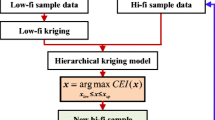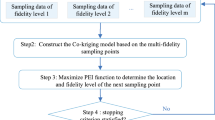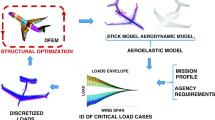Abstract
This paper presents a reformulation of the “Gappy Proper Orthogonal Decomposition” (Gappy-POD) multi-fidelity modeling approach and proposes an enrichment criterion associated with an adaptive infill algorithm. The latter is here applied to the study of the flight domain of the RAE-2822 transonic airfoil at two different levels of accuracy to demonstrate its ability to detect areas in a two-dimensional design space where the surrogate model needs improvement to better drive the optimization process.











Similar content being viewed by others
References
Braconnier T, Ferrier M, Jouhaud JC, Montagnac M, Sagaut P (2011) Towards an adaptive pod/svd surrogate model for aeronautic design. Comput Fluids 40(1):195–209. doi:10.1016/j.compfluid.2010.09.002
Brand M (2006) Fast low-rank modifications of the thin singular value decomposition. Linear Algebra Appl 415(1):20–30. doi:10.1016/j.laa.2005.07.021
Bui-Thanh T (2003) Proper orthogonal decomposition extensions and their applications in steady aerodynamics. Master?s thesis, Ho Chi Minh City University of Technology
Bui-Thanh T, Damodaran M, Willcox KE (2004) Aerodynamic data reconstruction and inverse design using proper orthogonal decompositionn. AIAA J 42(8):1505–1516. doi:10.2514/1.2159
Cambier L, Heib S, Plot S (2013) The onera elsa cfd software : input from research and feedback from industry. Mech Ind 14(3):159–174. doi:10.1051/meca/2013056
Conn AR, Gould NIM, Toint PL (2000) Trust region methods. Mos-siam series on optimization
Cook PH, McDonald MA, Firmin MCP (1979) Aerofoil rae 2822 - pressure distributions, and boundary layer and wake measurements. In: Agard report ar, vol 138
Drela M (1989). In: Drela M (ed) Xfoil: an analysis and design system for low reynolds number airfoils. Springer, pp 1–12
Everson R, Sirovich L (1995) Karhunen-loeve procedure for gappy data. J Opt Soc Am A 12(8):1657–1664. doi:10.1364/JOSAA.12.001657
Fang F, Pain CC, Navon IM, Gorman GJ, Piggott MD, Allison PA, Farrell PE, Goddard AJH (2009) A POD reduced order unstructured mesh ocean modelling method for moderate reynolds number flows 28(1):127–136. doi:10.1016/j.ocemod.2008.12.006
Coelho F, Rajan PB, Knopf-Lenoir C (2008) Model reduction for multidisciplinary optimization - application to a 2d wing. Struct Multidiscip Optim 37(1):29–48. doi:10.1007/s00158-007-0212-5
Coelho F, Rajan PB, Knopf-Lenoir C, Villon P (2009) Bi-level model reduction for coupled problems. Struct Multidiscip Optim 39(4):401–418. doi:10.1007/s00158-008-0335-3
Forrester AIJ, Keane AJ (2009) Recent advances in surrogate-based optimization. Prog Aerosp Sci 45 (1–3):50–79. doi:10.1016/j.paerosci.2008.11.001
Forrester AIJ, Sóbester A, Keane AJ (2008) Engineering design via surrogate modelling: A practical guide. Wiley
Gogu C, Haftka R, Le Riche R, Molimard J, Vautrin A (2009) Dimensionality reduction of full fields by the principal components analysis. In: Proceedings 17th international conference on composite materials (iccm17), pp 14–7
Guénot M, Lepot I, Sainvitu C, Goblet J, Coelho RF (2011) Adaptive sampling strategies for non-intrusive pod-based surrogates. In: Proceedings EUROGEN 2011 evolutionary and deterministic methods for design, optimization and control. CIRA, Capua
Guénot M, Lepot I, Sainvitu C, Goblet J, Coelho RF (2013) Adaptive sampling strategies for non-intrusive pod-based surrogates. Eng Comput 30(4):521–547. doi:10.1108/02644401311329352
Han ZH, Görtz S, Hain R (2010) A variable-fidelity modeling method for aero-loads prediction. In: Dillmann A, Heller G, Klaas M, Kreplin H-P, Nitsche W, Schröder W (eds) New results in numerical and experimental fluid mechanics vii. doi:10.1007/978-3-642-14243-7_3. Springer, pp 17–25
Han Z-H, Görtz S, Zimmermann R (2013) Improving variable-fidelity surrogate modeling via gradientenhanced kriging and a generalized hybrid bridge function. Aerosp Sci Technol 25(1):177–189. doi:10.1016/j.ast.2012.01.006
Han Z-H, Zimmermann R, Görtz S (2010) A new cokriging method for variable-fidelity surrogate modeling of aerodynamic data. In: Proceedings 48th aiaa aerospace sciences meeting including the new horizons forum and aerospace exposition. doi:10.2514/6.2010-1225. AIAA
Huang L, Gao Z, Zhang D (2013) Research on multi-fidelity aerodynamic optimization methods. Chin J Aeronaut 26(2):279–286. doi:10.1016/j.cja.2013.02.004
Keane AJ (2003) Wing optimization using design of experiment, response surface, and data fusion methods. J Aircr 40:741–750. doi:10.2514/2.3153
Keane AJ, Prasanth B (2005) Nair. Wiley, Computational approaches for aerospace design: the prusuit of excellence
Kennedy MC, O’Hagan A (2000) Predicting the output from a complex computer code when fast approximations are available. Biometrika 87(1):1–13. doi:10.1093/biomet/87.1.1
Koziel S, Leifsson L (2012) Surrogate-based aerodynamic shape optimization by variable-resolution models. AIAA J 51(1):94–106. doi:10.2514/1.J051583
Kuya Y, Takeda K, Zhang X, Forrester AIJ (2011) Multifidelity surrogate modeling of experimental and computational aerodynamic data sets. AIAA J 49(2):289–298. doi:10.2514/1.J050384
Leifsson L, Koziel S (2010) Multi-fidelity design optimization of transonic airfoils using physics-based surrogate modeling and shape-preserving response prediction. J Comput Sci 1(2):98–106. doi:10.1016/j.jocs.2010.03.007
Leifsson L, Koziel S (2015) Surrogate modelling and optimization using shape-preserving response prediction: a review
Peña Lopez F, Díaz Casäs VD, Gosset A, Duro RJ (2012) A surrogate method based on the enhancement of low fidelity computational fluid dynamics approximations by artificial neural networks. Comput Fluids 58:112–119. doi:10.1016/j.compfluid.2012.01.008
Luliano Emiliano, Quagliarella Domenico (2013) Proper orthogonal decomposition, surrogate modelling and evolutionary optimization in aerodynamic design. Comput Fluids 84:327–350. doi:10.1016/j.compfluid.2013.06.007
Lumley JL (1967). In: Lumley JL (ed) The structure of inhomogeneous turbulent flows. Nauka, pp 166–178
March A, Willcox K (2012a) Constrained multifidelity optimization using model calibration. Struct Multidiscip Optim 46(1):93–109. doi:10.1007/s00158-011-0749-1
March A, Willcox K (2012b) Provably convergent multifidelity optimization algorithm not requiring high-fidelity derivatives. AIAA J 50(5):1079–1089. doi:10.2514/1.J051125
Quarteroni A, Rozza G (2014) Reduced order methods for modeling and computational reduction. Vol. 9 of Ms&a - modeling, simulation and applications. Springer
Raghavan B, Breitkopf P (2013) Asynchronous evolutionary shape optimization based on high-quality surrogates: application to an air-conditioning duct. Engineering with Computers 29(4):467–476. doi:10.1007/s00366-012-0263-0
Romero VJ, Burkardt JV, Gunzburger MD, Peterson JS (2006) Comparison of pure and “latinized” centroidal voronoi tessellation against various other statistical sampling methods. Reliab Eng Syst Saf 91(10–11):1266–1280. The Fourth International Conference on Sensitivity Analysis of Model Output (SAMO 2004)SAMO 2004The Fourth International Conference on Sensitivity Analysis of Model Output (SAMO 2004). doi:10.1016/j.ress.2005.11.023
Saka Y, Gunzburger M, Burkardt J (2007) Latinized, improved lhs, and cvt point sets in hypercubes. Int J Numer Anal Model 4(3–4):729–743
Sirovich L (1987) Turbulence and the dynamics of coherent structures, part1: Coherent structures. Vol. 45 of Quarterly of applied mathematics. Brown University, Division of Applied Mathematics
Spalart PR, Allmaras SR (1992) A one-equation turbulence model for aerodynamic flows. In: Proceedings 30th aerospace sciences meeting & exhibit. doi:10.2514/6.1992-439. AIAA
Toal DJ (2014) On the potential of a multi-fidelity g-pod based approach for optimization & uncertainty quantification. Asme turbo expo 2014: Turbine technical conference and exposition 2B. doi:10.1115/GT2014-25184
Toal DJ, Keane AJ (2011) Efficient multipoint aerodynamic design optimization via cokriging. J Aircr 48 (5):1685–1695. doi:10.2514/1.C031342
Tromme E, Brüls O, Emonds-Alt J, Bruyneel M, Virlez G, Duysinx P (2013) Discussion on the optimization problem formulation of flexible components in multibody systems. Struct Multidiscip Optim 48 (6):1189–1206. doi:10.1007/s00158-013-0952-3
Xiao M, Breitkopf P, Coelho RF, Knopf-Lenoir C, Sidorkiewicz M, Villon P (2010) Model reduction by cpod and kriging. Struct Multidiscip Optim 41(4):555–574. doi:10.1007/s00158-009-0434-9
Xiao M, Breitkopf P, Coelho RF, Knopf-Lenoir C, Villon P, Zhang W (2013) Constrained proper orthogonal decomposition based on qrfactorization for aerodynamical shape optimization. Appl Math Comput 223 (0):254–263. doi:10.1016/j.amc.2013.07.086
Xiao M, Breitkopf P, Coelho RF, Villon P, Zhang W (2014) Proper orthogonal decomposition with high number of linear constraints for aerodynamical shape optimization. Appl Math Comput 247(0):1096–1112. doi:10.1016/j.amc.2014.09.068
Acknowledgments
The present work was partly founded by the Association Nationale de la Recherche et Technologie. The authors would like to thank Snecma from the SAFRAN Group for their support and permission to publish this study and especially Dr. Mickaël Meunier and Ir. Jean Coussirou for their technical support in this research project. Last but not least, the authors would like to acknowledge the three anonymous reviewers whose comments helped improve and clarify this manuscript.
Author information
Authors and Affiliations
Corresponding author
Rights and permissions
About this article
Cite this article
Benamara, T., Breitkopf, P., Lepot, I. et al. Adaptive infill sampling criterion for multi-fidelity optimization based on Gappy-POD. Struct Multidisc Optim 54, 843–855 (2016). https://doi.org/10.1007/s00158-016-1440-3
Received:
Revised:
Accepted:
Published:
Issue Date:
DOI: https://doi.org/10.1007/s00158-016-1440-3




